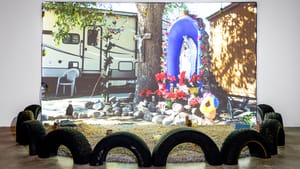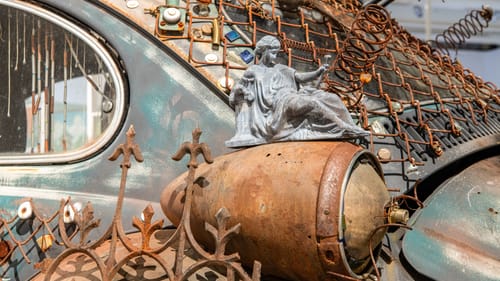Stay in the Loop
BSR publishes on a weekly schedule, with an email newsletter every Wednesday and Thursday morning. There’s no paywall, and subscribing is always free.
Art without walls
The Institute for Contemporary Art presents Where I Learned to Look: Art from the Yard

Whether it’s a set of front steps or a spacious lawn, what you do with the space beyond your walls says something about you. In Where I Learned to Look: Art from the Yard at the Institute for Contemporary Art (ICA), guest curator Josh T. Franco considers what artists express in work made for the outdoors.
Rasquachismo and La Virgen
Franco’s Preparing La Virgen (2023) leads off the exhibition, which includes 30 self-taught and formally trained creators. Combining film with installation, Franco depicts members of the Sanchez family decorating a shrine dedicated to the Virgin of Guadalupe in the location where she is believed to have appeared years ago, an area that’s now a neighborhood of tract houses and trailers.
A statue of the virgin stands in a repurposed bathtub, upended, painted celestial blue, and framed in river rocks. A crucifix stands to her right. As the frames click by, multiple Sanchez generations tuck silk roses between the stones and wind-colored lights around a star frame. The virgin’s December 12 feast is approaching, and they want to identify this as the site of a miracle.
The pocket shrine spills into real-time. An apron of gravel, decorated with pillar candles and edged in halved tires, pools on the gallery floor. In text superimposed on the screen, Franco, writing as the virgin, explains how her image has been adopted and transformed by New World cultures, transcending her Christian identity as Jesus’s mother. Standing in the gallery, we are drawn into the meaning of the Sanchez family’s observance.
In gallery notes, Franco says this piece exemplifies rasquachismo—a working-class aesthetic among Chicano and Mexican artists of “doing the most with the least,” a style of practice asserting empowerment and resistance. Rasquachismo can be sensed throughout Art from the Yard and dovetails with the objective of ICA’s guest curator initiative to support emerging and under-recognized creative practices.
The patina of time
Noah Purifoy’s (1917-2004) practice centered on found objects and social change. His early sculptures incorporated debris from Los Angeles’s 1965 Watts riots. Beyond his own practice, Purifoy worked to bring art into California prisons and, in the last 15 years of his life, established the Outdoor Desert Art Museum of Assemblage Sculpture, an open-air found-item collection in Joshua Tree, California.
Untitled (2002), Purifoy’s shadowbox of a scruffy backyard, demonstrates his affection for detritus. Composed entirely of wood scraps, the palette is brown on brown on brown. Everything looks worse for wear: the house is exhausted, the steps rickety, the window crooked. Purifoy considered time and weather his collaborators, and their contributions are evident.
Joyous choreography, modest living
Franco describes his grandfather as a “prolific yard artist” whose enchanting, hand-built environments inspired him. “These were the unexpected training grounds for my earliest exercises in close observation, a skill central to my work,” the West Texas artist and art historian has said. “My grandfather’s yard is where I learned to look.” This makes it no surprise that in addition to rasquachismo, Franco brought an intergenerational perspective to developing Art from the Yard with ICA curators Hallie Ringle and Denise Ryner.
The landscaping so closely identified with Mexican and Chicano laborers becomes joyous choreography in the hands of Rubén Ortiz Torres (b. 1964). In the video The Garden of Earthly Delights (2002), he combines Gabriella Ortiz’s syncopated soundtrack of birdsong, rustling grass, and buzzy tools with Salvador “Chava” Muñoz’s tricked-out riding mower, which stretches and spins, dancing to the music.
Modest Livelihood (2012), a film by Brian Jungen (b. 1970) and Duane Linklater (b. 1976), responds to a 1999 Canadian Supreme Court decision limiting Indigenous hunting and fishing rights to an amount needed to “maintain basic necessities of life.” The filmmakers follow three First Nation hunters as they quietly and methodically track, capture, and field dress prey on foot, underscoring the hypocrisy of strictly regulating ancestral practices while granting wide latitude to corporate interests’ destructive, highly mechanized operations in nature.
Art in Charm City

Maryland might be the yard art Mecca. In Hyattsville, Clarke Bedford (b. 1947) established Vanadu (van and Xanadu), an outdoor museum of found elements, including 2016’s riveting Art Car (Volkswagen), temporarily parked at ICA. Festooned with enough objects to fill a season of Antiques Roadshow, the Beetle wears a crown of pointy finials, evoking Moscow’s Red Square. A klaxon bursts from the rear window, big enough to fend off any tailgater. The doors bear shields of star-posed figures surrounded by mirrored sunbursts. The hood is capped with a teapot, and faucets drip down the radiator front, a giant VW samovar. All available space is bedecked with lanterns, springs, chain-link fencing, wrought-iron edging, dials, jewels, gears, projector reels, a model skull, and a seashell. And in case we wonder, Art Car is said to be drive-able.
Baltimore’s Painted Screen Society carries on the tradition of using regular household screens as canvases. The work of 10 members is displayed on a gallery divider, from nostalgic portraits of an ice man with his horse and wagon and snowy lamplit streets to an alien arising from a gloomy, dark horizon to a trio of neighborhood gals with beehive hairdos, ready for gossip.
A beautifully surreal view
Jeff Koons, Art from the Yard’s best-known artist, also produced the most recognizable example: his 2013 Gazing Ball (Birdbath). Dating to the 13th century, mirrored orbs have an aristocratic pedigree but became a fixture in the yards of proud mid-20th-century middle-class homeowners. Koons remembers them from his youth in the Philadelphia suburbs, and they’re still not hard to find, providing a beautifully surreal view of the world—which is kind of the point of all yard art.
What, When, Where
Where I Learned to Look: Art from the Yard. Through December 1, 2024, at the Institute of Contemporary Art, University of Pennsylvania, 118 South 36th Street, Philadelphia. (215) 898-5911 or icaphila.org.
Accessibility
All public spaces at the Institute of Contemporary Art can be reached by a wheelchair-accessible elevator. Wheelchair-accessible restrooms are located on the first floor. Gallery stools, large-print guides, and earplugs are available; service animals are welcome. For information, contact the visitor services director at [email protected] or call (215) 898-5911.
Sign up for our newsletter
All of the week's new articles, all in one place. Sign up for the free weekly BSR newsletters, and don't miss a conversation.
